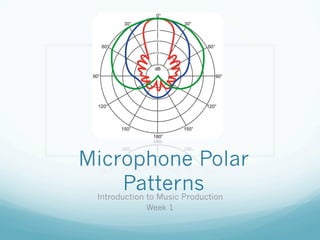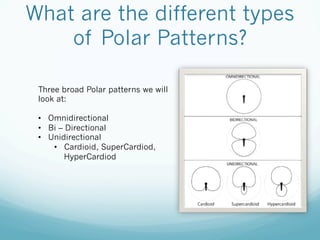Polar patterns
- 1. Microphone Polar Patterns Introduction to Music Production Week 1
- 2. Letâs begin Hello class, My name is Arjun Nair, from Mumbai, India. Iâm going to be attempting to take you through a specific aspect of Microphones which interest me, viz. Polar Patterns Hereâs what weâre going to try and cover in this lesson: âĒâŊ What do we mean by Polar Patterns for a Microphone? âĒâŊ What are the different types of patterns that exist? Types, Uses and Examples. âĒâŊ Basics to keep in mind while choosing between Polar patterns for your Microphone This lesson will be more useful if youâve covered Microphone as a Transducer, and Microphone types available at the following link (https:// class.coursera.org/musicproduction-001/lecture/19)
- 3. What are polar patterns? âïâŊ The polar pattern of a microphone refers how well it âhearsâ sound from different directions. âïâŊ It refers to what areas of the Microphone are sensitive to the sound pressure directed at it well and what areas reject it. âïâŊ Every Microphone can be designed with any type of pattern âïâŊ These polar patterns can be represented diagrammatically
- 4. What are the different types of Polar Patterns? We will look at three main patterns in their following aspects: âĒâŊ What (How the Microphone will hear the sound) âĒâŊ What are the possible uses/advantages of such a Polar Pattern in a Microphone? âĒâŊ An example of a microphone designed with such a polar pattern
- 5. What are the different types of Polar Patterns? Three broad Polar patterns we will look at: âĒâŊ Omnidirectional âĒâŊ Bi â Directional âĒâŊ Unidirectional âĒâŊ Cardioid, SuperCardiod, HyperCardiod
- 6. Omnidirectional What : âĒâŊ With this Polar pattern, the Microphone picks up sound equally well from all directions. The Mic picks up everything within the given space. Uses: âïâŊ When the Microphone needs to pick up ambient sound âĒâŊ When the Microphone is used in an environment where sound sources are moving (since itâs not practical to have a mic move with these sound sources ;) )
- 8. Bi â Directional What: âĒâŊ As the name suggests, with this Polar pattern, the Microphone picks up sound equally best in two directions -- in front of and behind the mic -- and rejects sounds to the sides âĒâŊ Also known as âFigure 8â pattern
- 9. Bi â Directional Uses: âĒâŊ This is useful in recording Dual sources simultaneously âĒâŊ Creatively used in recordings also because of the areas that Do NOT pick up sound.
- 10. Bi â Directional Example: âĒâŊ Ribbon Microphones âĒâŊ Blue Microphones - Woodpecker Active Ribbon Microphone
- 11. Unidirectional
- 12. Cardiod What: âïâŊ With this Polar pattern, the Microphone picks up sound best in front of the mic and Partly rejects sounds approaching the sides or rear of the mic. Cardiod mics reject sound best toward the rear. âïâŊ The pattern resembles the shape of a human heart, and hence the name
- 14. SuperCardiod What: âïâŊ With this Polar pattern, the Microphone picks up sound best in front of the mic. It partly rejects sounds approaching the sides or rear of the mic. âïâŊ It has a "Tighter" or more narrow pickup than cardioid.
- 15. SuperCardiod Example: CAD 25A Dynamic Supercardioid Microphone
- 16. HyperCardiod What: âïâŊ With this Polar pattern again, the Microphone picks up sound best in front of the mic. It partially rejects sounds approaching the sides or rear of the mic. âïâŊ It has a "Tighter" or more narrow pickup than SuperCardioid.
- 17. HyperCardiod Example: Audix OM6 Broad Hypercardioid Microphone
- 18. Differentiation âĒâŊ Primarily differentiated based on not just the pick up, but what it rejects Cardiod SuperCardiod Hypercardiod âĒâŊ Picks up maximum âĒâŊ Narrower pickup âĒâŊ Narrower pickup towards the front than Cardiod than SuperCardiod âĒâŊ Offers maximum âĒâŊ Also has some rear âĒâŊ Also has more rear rejection (null) at pickup pickup than the rear of the SuperCardiod microphone.
- 19. Uses for UniDirectional âĒâŊ Cardiod âĒâŊ Used for live sound, for vocals for instance, since it picks up concentrated sound and eliminates ambient sound like the stage monitors. âïâŊ Supercardioid âïâŊ Good for stage-floor miking âïâŊ More isolation than a cardioid âïâŊ Less reverb pickup than a cardioid âïâŊ Hypercardioid âïâŊ Maximum side rejection in a unidirectional mic âïâŊ Maximum isolation--maximum rejection of reverberation, leakage, feedback, and background noise
- 20. Concluding Tips A few things to keep in Mind while choosing between polar patterns: âĒâŊ Most microphones boost the bass when used up close. That adds a warm, full tone quality. Microphones with an omnidirectional polar pattern do not have proximity effect. âĒâŊ Choose an omni if you want the most natural sound and don't mind about sound being picked up from all around, like recording crowd reactions in a stadium. âĒâŊ Choose any directional mic if you want to reject sounds from certain directions, or if you want a bass boost for a nearby source, such as a vocalist. A cardioid will be a good all-round choice. âĒâŊ Choose a Supercardioid mic if you want a tighter focus than a SuperCardioid âĒâŊ Choose a hypercardioid mic if you want a tighter focus than a SuperCardioid. âĒâŊ Choose a figure-of-eight if you want to reject sound sources coming from the sides, or if you want to use a two mics for stereo.




















